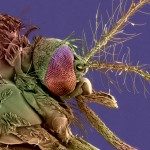Link to Pubmed [PMID] – 18447623
Vector Borne Zoonotic Dis. 2008 Oct;8(5):589-95
To identify the mosquito species able to sustain the transmission of West Nile Virus (WNV) in the Camargue region (the main WNV focus of southern France), we assessed the vector competence of Culex modestus and Culex pipiens, the most abundant bird-feeders, and Aedes caspius, the most abundant mammophilic species occasionally found engorged with avian blood. Female mosquitoes were exposed to the infectious meal (10(10.3) plaque forming units (PFU)/mL) by membrane feeding, and hold at 26 degrees C. After the incubation period, disseminated infection was assessed by WNV detection using an indirect fluorescent antibody assay (IFA) on head squashes, and the transmission rate was assessed by the presence of WNV RNA in salivary secretions with a real-time reverse transcriptase-polymerase chain reaction (RT-PCR). After 14 incubation days, the disseminated infection and the transmission rates were 89.2% and 54.5% for Cx. modestus, 38.5% and 15.8% for Cx. pipiens, and 0.8% and 0 for Ae. caspius. Culex modestus was found to be an extremely efficient laboratory WNV vector and could thus be considered the main WNV vector in wetlands of the Camargue. Culex pipiens was a moderately efficient laboratory WNV vector, but in dry areas of the region it could play the main role in WNV transmission between birds and from birds to mammals. Aedes caspius was an inefficient vector of WNV in the laboratory, and despite its high densities, its role in WNV transmission may be minor in southern France.

